
Renaissance (1300-1600s)

Renaissance
(1300-1600s)
For Nature has so planned the human body that...if a man lies on his back with hands and feet outspread, and the centre of a circle is placed on his navel, his figure and toes will be touched by the circumference. - Leonardo da Vinci (http://www.aiwaz.net/Leonardo/)

Leonardo da Vinci - Vitruvian Man - c. 1492
-
http://daphne.palomar.edu/mhudelson/Art100_Pages/Art100_WoA_Chaps/Art100_WorksofArt_Chap4.html
See other works of art from the Renaissance at this site published by
Professor Hudelson, Palomar College
During the era known by this name, Europe emerged from the economic stagnation of the Middle Ages and experienced a time of financial growth. Also, and perhaps most importantly, the Renaissance was an age in which artistic, social, scientific, and political thought turned in new directions (http://www.learner.org/exhibits/renaissance/)
Like other great changes in history, the Renaissance did not replace the Middle Ages overnight. Nor did the change take place at the same time everywhere in Europe. The Renaissance began in Italy around 1300. Later, its new styles of art, writing, and thought spread northward to the Netherlands, France, Germany, and England.
It is important to remember that early writers and artists of the Renaissance were creating their masterpieces in Italy while France and England were still locked in the Hundred Years' War. The bustling cities of northern Italy seem to be in a different world from the feudal villages of northern Europe, but both existed at the same time (WH, p. 345).
New values shaped the Renaissance.
Celebration of the individual - Artists in the Middle Ages did their work skillfully. In general, however, they did not win fame as individuals. The glassmakers, stonecutters, and wood-carvers of the great cathedrals worked for the glory of God, not for personal glory. By the 1300's, however artists and writers in northern Italy were eager to be known and remembered as individuals. From this time on, we know the names of people who created works of art. Fame was the final reward for superior talent (WH, p. 347).
Love of classical learning - Renaissance scholars despised the art and literature of the Middle Ages and loved the writings of ancient Greece and Rome. Scholars who studied classical texts were called humanists, from the Latin word humanitas. Under the influence of the humanists, all painting, sculpture, and architecture carried on the traditions of ancient Greece and Rome (WH, p. 348).
Enjoyment of worldly pleasures - In contrast to the Middle Ages where devoutly religious people proved their piety by wearing poor, rough clothing and living on the plainest foods, Renaissance humanists suggested that a person might love and enjoy life without offending God (WH, p. 348).
1300's - Rise of independent cities in northern Italy ushers in the Renaissance (WH, p. 341).

Giotto di Bondone - Cappella Scrovegni (Arena
Chapel), Padua -1303-06
http://www.mitsos.net/culture/paints/artist_dh/g/giotto/scrovegni/Description.htm
1303-06 - Giotto di Bondone started painting biblical scenes on wet plaster, known as fresco painting, on the Arena Chapel in Padua, Italy. Giotto painted human figures that looked real and lifelike, with bodies and faces that seemed fully rounded. His style created an illusion of depth, which was a departure from the stiff-looking figures painted throughout the Middle Ages. Giotto's acclaimed frescoes began a revolution in art (WH, p. 346-7).

Gustave Dore (1832-83) - The Saintly Throng in the
Form of a Rose - The Divine Comedy - http://www.divinecomedy.org/divine_comedy.html
1304-06 - Dante Alighieri, 1265-1321, Italian poet, writes The Divine Comedy, a vernacular poem in 100 cantos (more than 14,000 lines), was composed in exile. It is the tale of the poet's journey through Hell and Purgatory (guided by Vergil) and through Heaven (guided by Beatrice, to whom the poem is a memorial.) Written in a complex pentameter form, terza rima, it is a magnificent synthesis of the medieval outlook, picturing a changeless universe ordered by God. Through it Dante established Tuscan as the literary language of Italy and gave rise to a vast literature (http://www.historychannel.com/). See http://www.divinecomedy.org/divine_comedy.html for the entire text of The Divine Comedy as well as images.
Who overrefines his argument
brings himself to grief. - Francesco Petrarch
(http://www.creativequotations.com/one/575.htm)
1304-1374 - Italian poet Petrarch, regarded as the first modern poet, perfected the sonnet form and deeply inspired many great poets, including Geoffrey Chaucer, Edmund Spenser, and William Shakespeare. He was one of the first humanists and raised the works of many classical writers from obscurity to prominence. He also played an important role in the development of Italian as a literary language (http://www.degrandis.com/d3/whopet.html).
1320 - The paper industry that is developing in Mainz, Germany, in 1320 will lead to the production of paper money in Europe. The Chinese had used paper currency in the 13th century, but abandoned it in the 14th when the notes outpaced treasury reserves. The production of paper in Germany also transforms written communication. Paper provides an alternative medium to vellum, which was expensive and not easily available (http://www.historychannel.com/).
1337-1453 - The Hundred Years' War between England and France. The English had held land in France for a long time, but lost Normandy in 1204. In 1337 Edward III declared himself king of France based on his mother's lineage. His ambition was the recovery of territories England used to held in France. His declaration was the onset of a long period of wars (http://www.librarius.com/chauchro.htm).
1350-1450 - The bubonic plague, also called the "Black Death", devastated one half of the population of Europe. The plague, which was almost always fatal, spread most rapidly in cities, where people were in close contact with each other. The only way to avoid the disease was to leave the city for the country. This solution was, unfortunately, available only to those wealthy enough to make the trip.
As incidence of the plague decreased in the late fifteenth century, populations swelled, creating a new demand for goods and services. A new middle class began to emerge as bankers, merchants, and tradespeople once again had a market for their goods and services (http://www.learner.org/exhibits/renaissance/middleages.html).
c. 1372-77 - Chaucer writes the poems later adapted as the Second Nun's Tale and the Monk's Tale in The Canterbury Tales, which represent the first time literature was written in Middle English, the language of the common people.
1378 - The Great Schism begins in the western Church as two men, Popes Urban VI and Clement VII, create competing papacies in Rome and Avignon, respectively. It will last until 1417 (http://www.historychannel.com/).
1400 - Geoffrey Chaucer's Death on 25 October. He is buried in Westminster Abbey. A tomb, erected by an admirer in the fifteenth century, marks his grave and his remains were subsequently moved. He was the first who was buried in what we now know as the 'Poets Corner' in Westminster Abbey (HM, p. 500).

Lorenzo Ghiberti - East Doors, Baptistery,
Florence - 1401-1452 -
http://www.artist-biography.info/gallery/lorenzo_ghiberti/59/
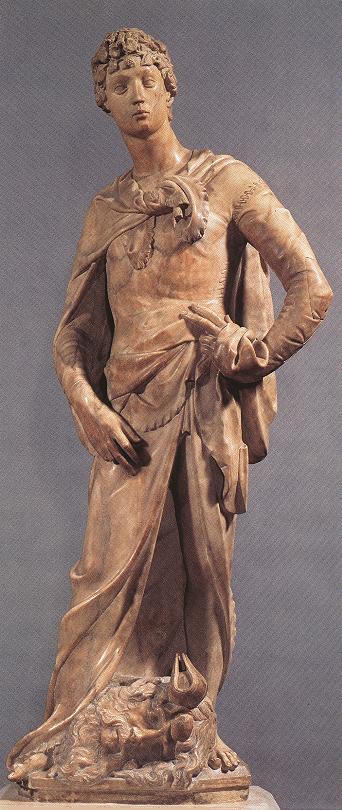 |
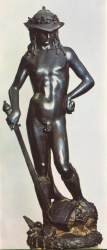 |
 |
|
Donatello - David - 1408-09 |
Donatello -
David - c. 1430 - Bronze |
Michelangelo - David -
1504 |
1408 - Donatello rejected the style of medieval stonecutters, who usually carved only the front of their human figures. The back side merged into a cathedral's walls. Above everything else, Donatello wanted his figures to seem real and alive. Like the ancient Greeks, Donatello wanted to show the strength and grace of the human form. In his statue "David," Donatello was the first European sculptor since ancient times to make a large, free-standing human figure in the nude (WH, p. 351).

Masaccio / Masolino* - Healing of the Cripple and
Raising of Tabatha (left view) - 1426-27
http://www.kfki.hu/~arthp/html/m/masolino/brancacc/healing.html
*Throughout the 19th century and the first decades of the 20th, scholars attributed this fresco to Masaccio, until 1929 when it was re-attributed to Masolino. Some critics claimed that there were sections painted by Masaccio. In 1940 it was suggested that Masaccio was responsible for the entire architectural background of the scene, including the figures in the background. This theory was accepted by almost all later scholars.
1426-7 - Masaccio was one of the most important painters of the 15th century and the founder of Renaissance painting. He took up the inheritance of Giotto, developing it according to the new techniques and methods of perspective*, thus giving the human figure a completely new, freer and more concrete position in the world.
*Perspective is a system developed in the early fifteenth century by Brunellischi, Alberti, Ucello, and Piero della Francseca for the representation of three dimensional objects in spatial recession on a two dimensional surface and continued to be used extensively until the twentieth century (http://www.deakin.edu.au/fac_edu/visarts/3Dim.htm).
Rules on how to use: Linear Perspective, Atmospheric Perspective, Shading (Value), and Compositional Models (http://www2.evansville.edu/studiochalkboard/draw.html).

Johann Gutenberg - The
Gutenberg Bible - 1454-5
http://www.humi.keio.ac.jp/treasures/incunabula/B42-web/high-light/illust004.html
1454-5 - The Gutenberg Bible - In the mid-fifteenth century Johannes Gutenberg invented a way of mechanising the production of printing type, as distinct from individually engraved or cast letters. This was the beginning of the mass production of books. The Gutenberg Bible was printed in Mainz around 1454-5. It is the first major book printed in the west. We have reason to believe that about 180 copies were printed and significant parts of 48 copies still survive. The British Library has two complete copies of the Gutenberg Bible and a small but important fragment of a third copy (http://prodigi.bl.uk/gutenbg/background.asp).

Sandro Botticelli - The
Birth of Venus - c. 1485-86 - painted for the villa of Lorenzo di
Pierfrancesco de' Medici at Castello -
http://www.ibiblio.org/louvre/paint/auth/botticelli/venus/
1485-1603 - Tudor dynasty rules England (WH, p. 341).
1492 - Christopher Columbus did not discover America (WH, p. 341).
"And we cannot reckon how great the damage is, since the mentioned merchants are taking every day our natives, sons of the land...because the thieves and men of bad conscience grab them...to be sold...our country is being completely depopulated, and Your Highness should not agree with this nor accept it as in your service...there should not be any trade of slaves nor outlet for them." - Christian King Affonso I of Kongo to the king of Portugal 1526 (WH, p. 369).
1500's - The slave trade began (WH, p. 341).
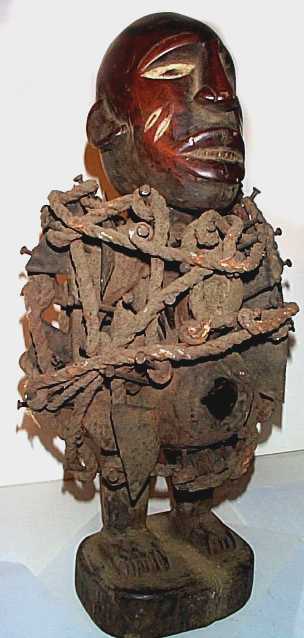
Power figure: nkisi -
http://www.tamarin.com/kongo/kongoe3.htm
A man paints with his brains and not with his hands. - Michelangelo
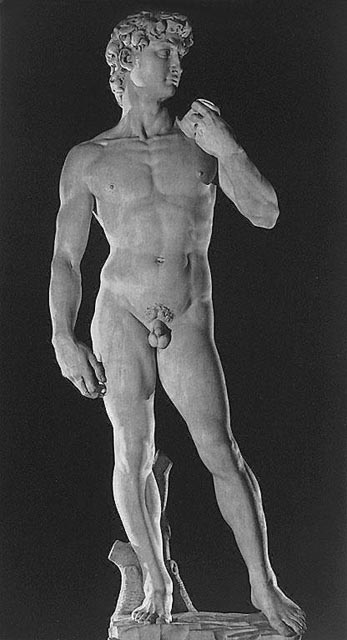
Michelangelo Buonarotti - David - 1501-04
http://www.thais.it/scultura/sch00065.htm
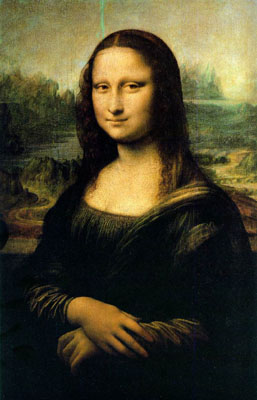
Leonardo da Vinci - La Joconde - Portrait of Mona Lisa
(1479-1528), also known as La Gioconda, the wife of Francesco del
Giocondo - 1503-06 -
http://www.ibiblio.org/wm/paint/auth/vinci/joconde/
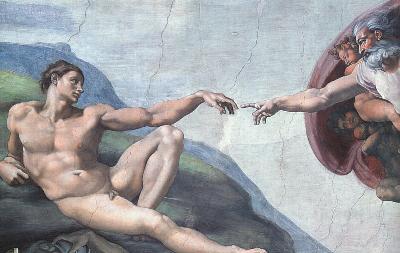
Michelangelo Buonarotti - The Creation of Man
(Fragment of the Sistine Chapel ceiling) - 1511-12 -
http://natalew.best.vwh.net/Art.html
(includes references and links to an assortment of art periods and
movements)
1508-12 - Michelangelo Buonarotti (1475-1564) completed painting the ceiling of the Sistene Chapel in the Vatican (HM, p. 341).
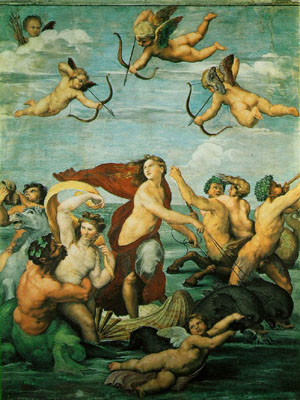
Raphael - The nymph Galatea - c. 1512-14
http://www.ibiblio.org/wm/paint/auth/raphael/galatea/
For injuries ought to be done all at one time, so that, being tasted less, they offend less; benefits ought to be given little by little, so that the flavour of them may last longer. - Niccolo Machiavelli - (http://www.the-prince-by-machiavelli.com/machiavelli-quotes.html)
1513 - As a result of two generations of political turmoil in Italy, Niccolo Machiavelli wrote a book of advice to rulers. The Prince is a book about power. How can a ruler gain power and keep it despite his enemies? asked Machiavelli. In answering this question, he began with the idea that most people are selfish, fickle, and corrupt. To succeed in such a wicked world, Machiavelli said, a prince must be strong as a lion and shrewd as a fox.
In The Prince, Machiavelli was not concerned with what was morally right but with what was politically effective. He believed that, in politics, the end justifies the means. According to The Prince, even immoral acts were justified if they served the interests of the state. Thus, although Machiavelli was himself an upright, honest, and religious man, his name has come to stand for trickery and double dealing (WH, p. 353).
See http://www.the-prince-by-machiavelli.com/, a website is dedicated to Niccolo Machiavelli and his book - The Prince.
1519 - Cortes conquers Mexico (WH, p. 341).
1519-1521 - Ferdinand Magellan commanded the fist globe-circling voyage, completed in 1522 after his death (HM, p. 500).
1521 - Luther begins religious revolt (WH, p. 341).
1543 - Nicolaus Copernicus proposed that the sun is the center of the universe (HM, p. 500).
1576 - London's first permanent theatre opened at Shoreditch, followed by the Curtain in 1577 and the Globe in 1598 (http://www.shawpittman.com/Home.nsf/b6a590459057e9bb8525679f00516522/client_guide_uk_neighborhood.htm).
1588 - England defeats the Spanish Armada (WH, p. 341).
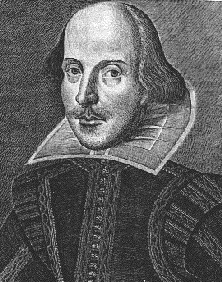
William Shakespeare - http://classics.mit.edu/Shakespeare/
1590-1616 - William Shakespeare wrote many of the world's greatest dramas (HM, p. 500) For an extensitve list of resources see: http://shakespeare.palomar.edu/
1600 - British East India Company founded in order to carve out a share of the rich East Indies spice trade (WH, p. 425).
1605 - Cervantes publishes Don Quixote (WH, p. 341).
1611 - King James Bible first printed (WH, p. 430).
The end of the Renaissance In both Italy and Northern Europe, the Renaissance had stirred a burst of creative activity. The work of the later German and Flemish masters marked its final phase. During the 1600's, new ideas and artistic styles appeared. Nonetheless Renaissance ideals continued to influence European life and thought. The Renaissance belief in the worth and dignity of the individual played a key role in the rise of democratic ideas (WH, p. 358).
Worth checking out: Drawing Prompts - Each artist link provides an opening representative image suitable for drawing by students. Additional images and information are also provided to help students explore the vast posibilities of artistic expression
|
|
Melissa and I would like to |